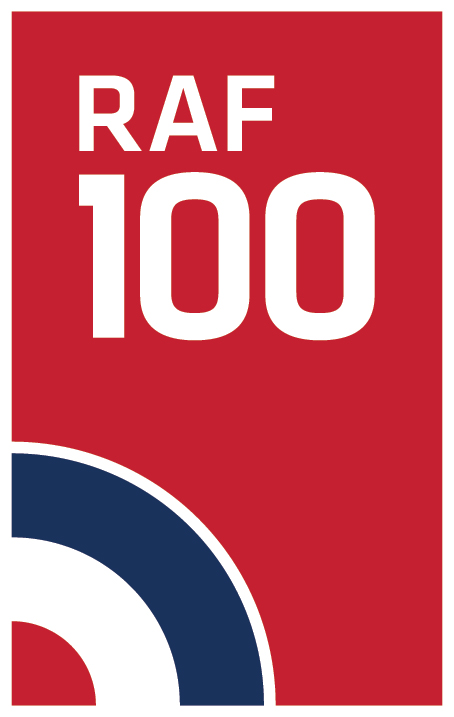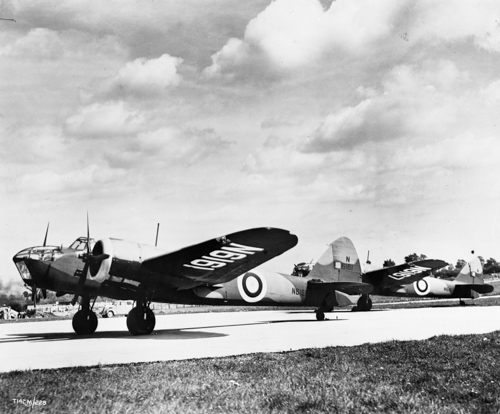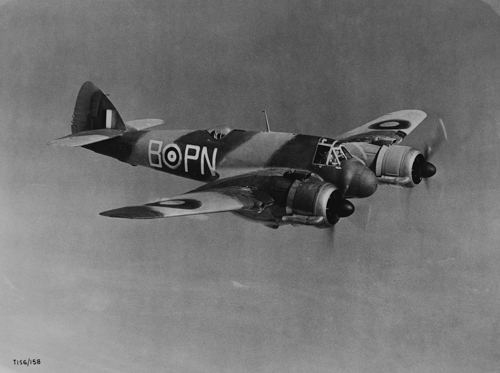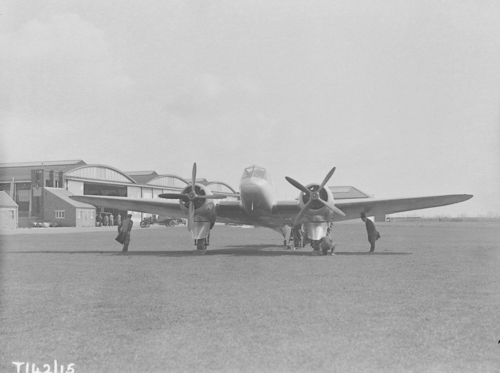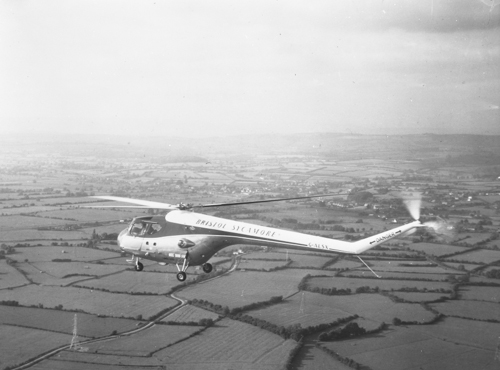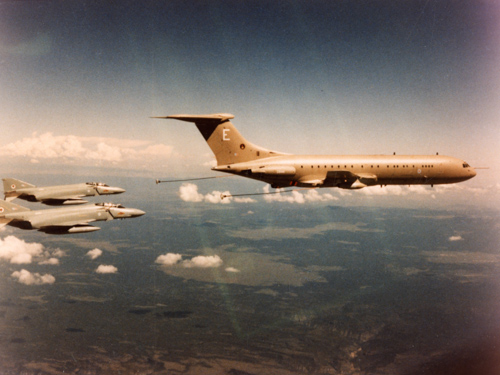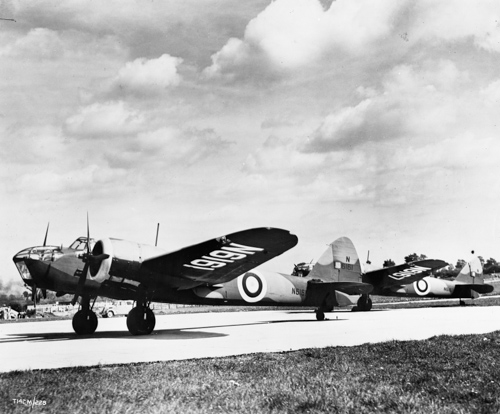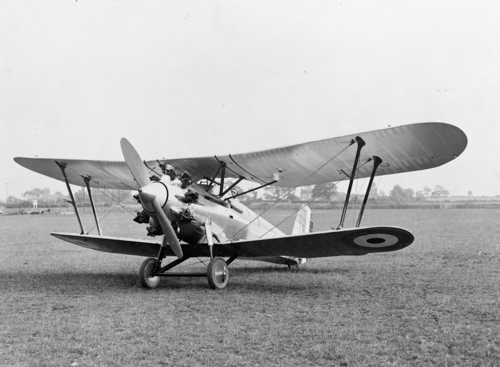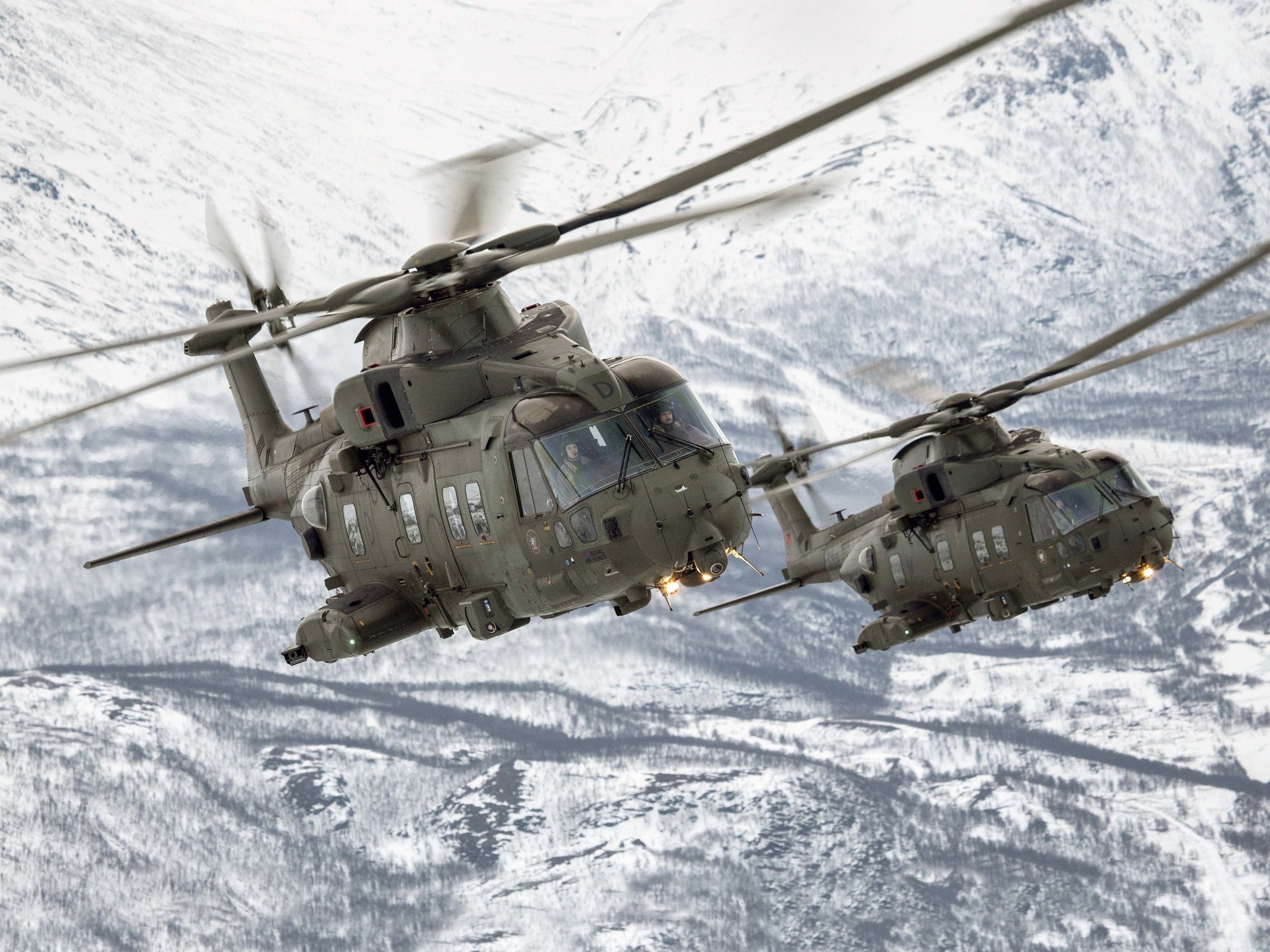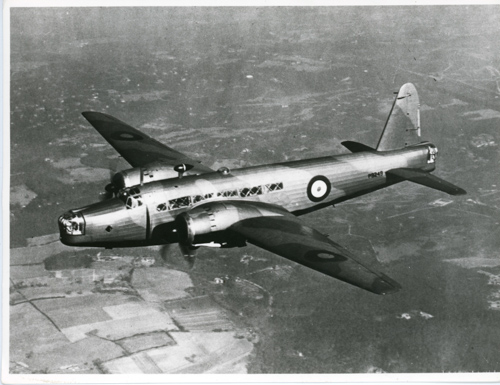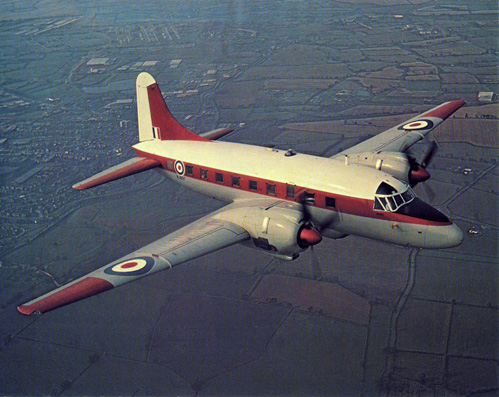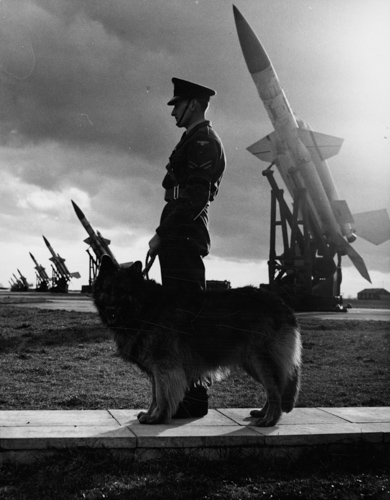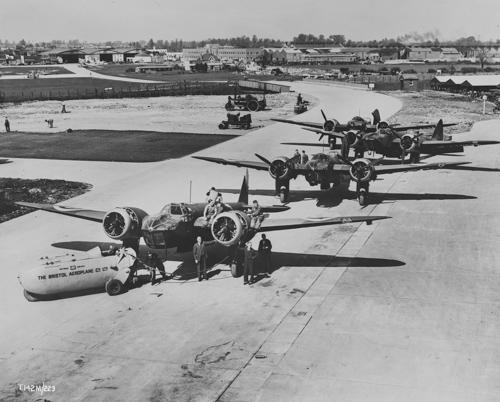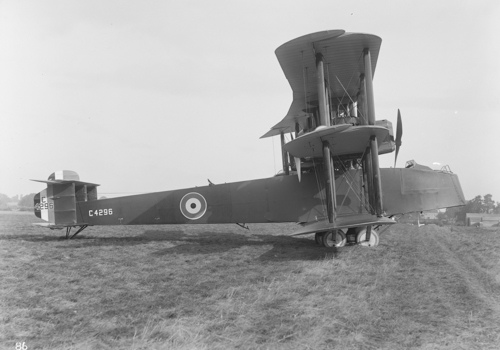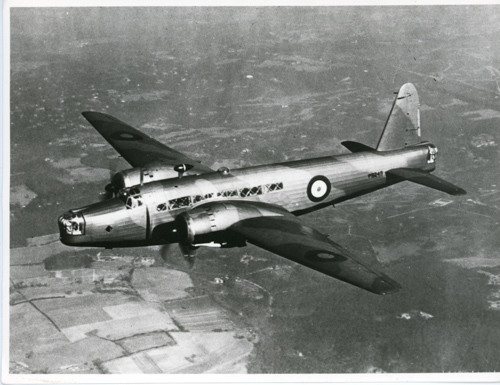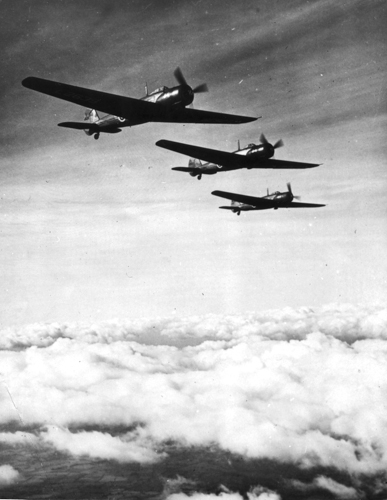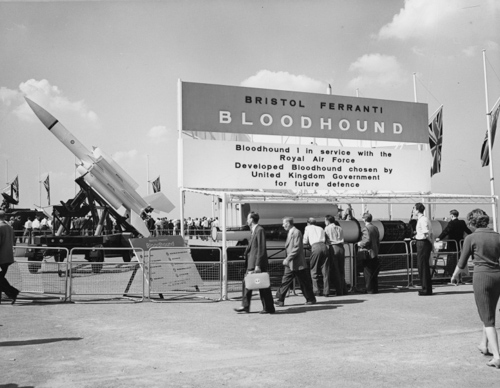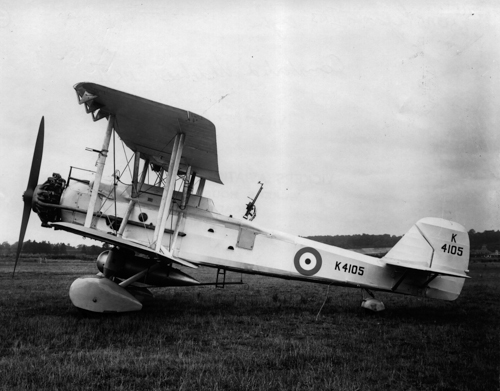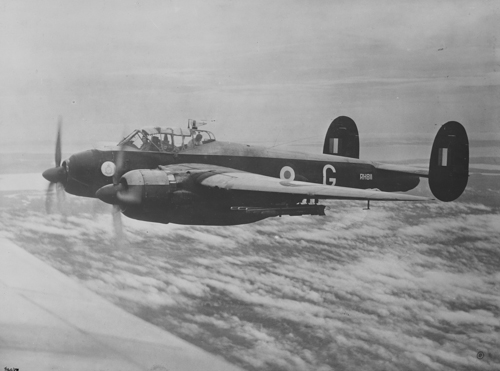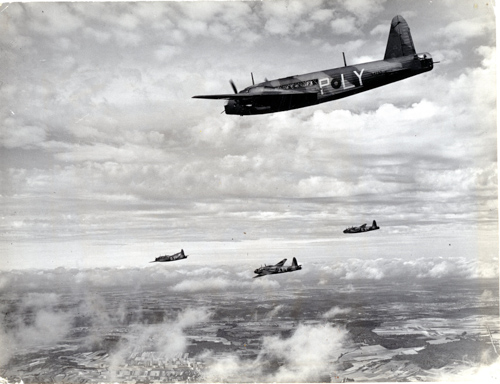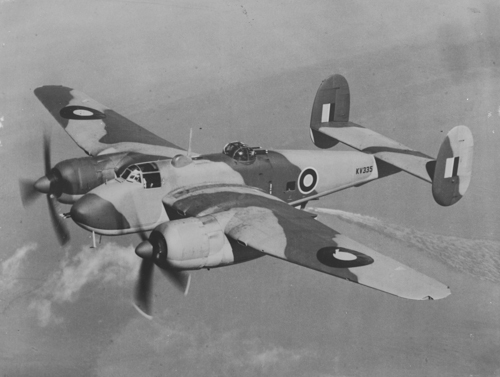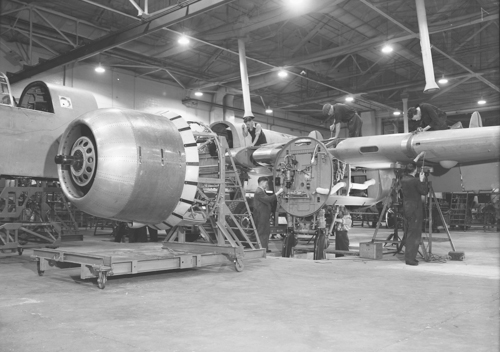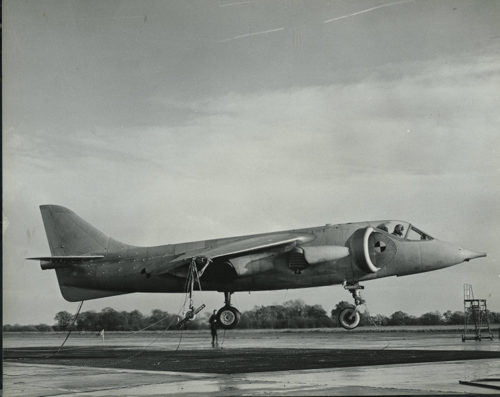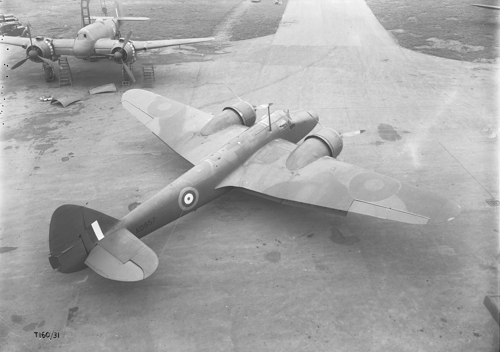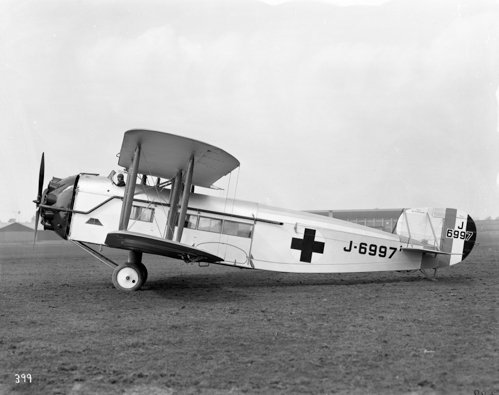The Royal Air Force, the world’s first independent air force, came into being on 1st April 1918
On 1 April 2018, the Royal Air Force celebrated its 100th anniversary.
Aerospace Bristol is marking this important occasion by reflecting on the history of the RAF and its connection with Filton as well as sharing incredible archive footage and very special events.
We hope you will be able to come along and celebrate with us throughout this important year.
The Royal Air Force and Filton
1915-1918
Filton's association dates back to the First World War, with the creation of the Aircraft Acceptance Park in 1915 which was manned by The Royal Flying Corps.
The three bay hangar which houses the main Aerospace Galleries was built in 1917 by the War Office as part of the Filton Aircraft Acceptance Park. It has enjoyed 100 years of continuous service in RAF and private hands. Manufacturers of airframes for use in the First World War delivered their aircraft to an Aircraft Acceptance Park for the installation of engines and armament. Squadrons were also prepared here before they were sent to the front lines in France. Although the Acceptance Park closed in late-1919, the large flying ground was taken over for test and development flying by the new Bristol Aeroplane Company.
1918
Formation of the Royal Air Force
1920 - 1940
In 1924, the Auxiliary Air Force was formed as part of the UK Volunteer Reserve forces. In 1927, the RAF returned to transform the site into the new RAF Filton, with many of the old Aircraft Acceptance Park buildings being incorporated into the extended site. The site was expanded during the 1920s and 1930s when Bristol Aeroplane Company operated a Flying Training School and in 1929 Bristol received its own AAF Squadron, No.501 (City of Bristol) Squadron, and in 1930 it was renamed the “County of Gloucester” Squadron. The squadron then operated from RAF Filton until 28th November 1939.
501 Squadron played a significant role in the Second World War and Filton was an important sector airfield during the Battle of Britain.
1950 - 1960
The 501 Squadron moved away from Bristol in 1940 serving with great distinction in France and then the Battle of Britain. It returned briefly in December 1940 before being dispatched to other areas of WW2. It was finally disbanded on 20th April 1945 but reformed at Filton on 10th May 1946, being finally disbanded on 10th March 1957.
During the 1950s-1960s Filton was designated as a V-bomber dispersal field.
1990 - date
RAF activity on the site decreased and the last Squadron, Bristol University Air Squadron, moved away 1992. Aerospace Bristol continues to commemorate the legacy between Filton and the RAF by using one of the original 1917 'Belfast' hangars as the new home of the museum. In 2015 the Grade 2 listed hangar became part of the Bristol Aero Collection Trust, who renovated the building and opened Aerospace Bristol in October 2017.
Bristol Type 23 Badger, 1919, outside Building 16S, on Aerodrome in 1919. Credit: BAE Systems
Bristol Blenheim: the company provided a variety of types of aircraft and engines to the RAF over the years. Credit: BAE Systems
Celebrating the raf100 - On this day...
1 April 1918
The Royal Air Force was formed by merging the Royal Flying Corps and Royal Naval Air Service. The first aircraft airborne on the day was a Bristol F2B Fighter.
In September and October 1917, orders for 1,600 Bristol F2B Fighters had been placed; by the end of the WW1, the RAF had a total of 1,583 F2Bs in squadron service; it was in service with six reconnaissance squadrons stationed in France and five Home Defence squadrons, while further squadrons operating the type were positioned in the Middle East and Italy. A total of 5,329 aircraft were eventually constructed, mostly by Bristol but also by Standard Motors, Armstrong Whitworth and even the Cunard Steamship Company. According to J.M. Bruce, by the time of the Armistice of 11 November 1918, which brought an end to the conflict, the "Bristol Fighter ended the war supreme in its class".
Credit: BAE Systems
3 April 1933
Squadron Leader Lord Clydesdale and Flight Lieutenant McIntyre flew a Westland PV-3 Wapiti Mk V prototype and a Westland PV-6 Wallace using 630HP Bristol Pegasus engines on the first flight over Mount Everest in the Houston-Everest Expedition.
Advert for Bristol Pegasus. Credit: BAE Systems
4 April 1943
A Bristol Beaufighter, torpedo-armed coastal version, accomplished the first successful military action for this Type by sinking 2 German supply ships off the Norwegian coast in WW2.
Credit: BAE Systems
5 April 1940
The second prototype Vickers Warwick, a multi-purpose twin-engined aircraft powered by a Bristol Centaurus engine, made its first flight. By January 1943, a total of 57 Warwick Mk I aircraft had been completed for the RAF. Production Warwick GR Mk IIs used Bristol Centaurus VI engines and other variants used Centaurus II, VII, and XII engines. The Warwick was flown by 167; 301; 304; 353; 525; 179; 621 Squadrons.
Credit: BAE Systems via Brooklands Museum
6 April 1941
A Bristol Beaufort of No. 22 Sqn St Eval bombed the German battleship Gneisenau in Brest harbour scoring a direct hit and nearly sinking the ship. The torpedo was released from a height of 30 ft after which Fg Off Kenneth Campbell was shot down and killed. He was posthumously awarded the Victoria Cross.
Credit: BAE Systems
7 April 1940
Bristol Blenheims Mk I or Mk IV were the first to spot the German Fleet leaving Kiel harbour under cover of bad weather to invade Denmark and Norway.
Credit: BAE Systems
12 April 1935
The Bristol Type 142, a twin-engined low-wing monoplane designed by Frank Barnwell for Lord Rothermere, owner of the Daily Mail newspaper, had been given the name Britain First, and conducted its maiden flight from Filton. Flight tests soon proved that the aircraft was in fact 50 mph faster than any fighter in service with the RAF at the time, having demonstrated a top speed of 307 mph. Rothermere presented the aircraft to the nation for a formal evaluation as a potential bomber. The design was subsequently adopted as the basis of the RAF's Bristol Blenheim medium bomber.
Credit: BAE Systems
18 April 1969
No. 1 Sqn received its first RAF Harriers using the Rolls-Royce (formerly Bristol-Siddeley) Pegasus vertical take off and landing engine.
Credit: BAE Systems via Brooklands Museum
25 April 1949
Second prototype Type 171 Bristol Sycamore helicopter was granted its certificate of airworthiness. This Type later entered service in the RAF.
Credit: BAE Systems
27 April 1994
First K Mk 4 tanker conversion of the VC-10 carried out at Filton was delivered to the Royal Air Force.
Credit: BAE Systems
30 April 1943
A Bristol Beaufighter VIF of No. 600 Sqn crewed by Flt Sgt Downing and Sgt Lyons shot down five Ju52 troop carriers near Setif in N. Africa. The action lasted just 10 minutes.
Credit: BAE Systems
5 May 1969
Between 4-11 May, A Harrier of No. 1 Sqn using the Rolls-Royce (formerly Bristol-Siddeley) Pegasus engine won the Daily Mail London - New York transatlantic air race. The flight involved 4 air-to-air refuellings and took 6 hr 11 min 57 sec.
Credit: BAE Systems via Brooklands Museum
7 May 1940 & 1946
A Bristol Beaufort of Coastal Command dropped the first 2,000lb (905kg) bomb during an attack on a German cruiser anchored off Norderney. Also on 7 May 1940, the first production Stirling conducted its first flight. The first few Stirling Mk.Is were furnished with Bristol Hercules II or III engines, but the majority were built with more powerful Hercules VI, X, XI or XVI engines. The Stirling was flown by 27 different RAF Squadrons.
On 7 May 1946, the first of two Handley Page Hastings prototypes (TE580) flew at RAF Wittering . The Hastings C.1 was rushed into service because of the Berlin Airlift, with No. 47 Squadron replacing its Halifax A Mk 9s with Hastings from September to October 1948. The Hastings C.1 was powered by four wing-mounted Bristol Hercules 100, 101 or 105 sleeve valve radial engines, whilst the C.2 used Hercules 106 or 216. The Hastings was flown by 17 RAF Squadrons.
Credit: BAE Systems
8 May 1929
The first of 25 Bristol Bulldog II ordered by the Air Ministry was delivered to the RAF. Deliveries to Nos. 3 and 17 Sqns continued until 10 October 1929. The RAF were delighted with their Bulldogs as much for their durability and ease of maintenance as for their lively handling qualities. The War in Europe ended with the German surrender on 8 May 1945. 14,000 Bristol aircraft and 101,000 Bristol engines were delivered during the Second World War.
Credit: BAE Systems
9 May 1940
As Germany invaded The Netherlands in WW2, 6 Bristol Blenheims Mk I or Mk IV of No. 600 Sqn attacked Waalhaven airport, only one Blenheim returning to
its base at RAF Manston.
Credit: BAE Systems
10 May 1940 & 1946
Thirty-three RAF Bristol Blenheims Mk IF or Mk IV attacked German forces in Holland, losing 3 aircraft in the process. Chamberlain resigned as Prime Minister. Mr Winston Churchill replaced him as head of a coalition government. The first RAF sortie was flown against Italy, by 26 Bristol Blenheim Mk Is and Mk IVs. On this day, following the German invasion of France and the low countries, Westland Lysander IIs powered by one 905 hp (675 kW) Bristol Perseus XII sleeve valve radial piston engine, were put into action as spotters and light bombers. The Westland Lysander I, II and III were flown by a total of 33 RAF Squadrons.
On 10 May 1946, 501 Squadron reformed at Filton.
Credit: BAE Systems
16 May 1960
The last Bristol Beaufighter in RAF service was scrapped at Seletar, Singapore.
Credit: BAE Systems
17 May 1927
Bristol Bulldog prototype made its first flight. It performed so well in its early handling trials that it made its first public appearance in the RAF display at Hendon in July 1927.
Credit: BAE Systems
1 June 2007
Flight Lieutenant Michelle Goodman, of 28 (AC) Squadron, RAF Benson, was awarded the Distinguished Flying Cross for a rescue that she conducted into Basra city flying an AgustaWestland Merlin HC3 helicopter. The Merlin is powered by the Rolls-Royce (at Patchway)/Turbomeca RTM322 turboshaft engine. The Merlin was operated by 28 (AC) Squadron and 78 Squadron at RAF Benson but Command of the UK Merlin HC3/3A fleet was formally transferred from the RAF to the Royal Navy on 30 September 2014.
Copyright: Leonardo
4 June 1959
The first Bristol Britannia 253/C Mk 1 was delivered to RAF Transport Command for Nos. 99 and 511 Squadrons.
Credit: BAE Systems
12 June 1942
Coastal Bristol Beaufighter of No. 236 Sqn flown by pilot Flt Lt Ken Gatward accompanied by observer FS George Fern flew a daylight operation over occupied Paris in WW2 and dropped a Tricolour flag onto the Tomb of the Unknown Soldier that was collected by the French Resistance. Afterwards the same crew shot up the German Admiralty headquarters in Paris and dropped a second flag on its doorstep.
Credit: BAE Systems
15 June 1936
The first twin-engined Vickers Wellington bomber prototype (Air Ministry Specification B9/32), K4049, made its first flight using 980hp Bristol Pegasus X engines. The production Wellington Mk I, some Mk IA and Mk IC used Bristol Pegasus XVIII engines. These Mks of Wellington subsequently served with 34 different RAF Squadrons.
Credit: BAE Systems via Brooklands Museum
18 June 1940
A French Intelligence officer attached to No. 1 Sqn found a Bristol Bombay abandoned on Chateaudun airfield with a broken tail-wheel. In spite of this damage, and regardless of the fact that he was not a qualified pilot, he took off successfully with 15 compatriots on board and flew to England to join the Free
French forces.
Credit: BAE Systems
21 June 1933
On 21 June 1933, the Supermarine Walrus prototype, a single-engine amphibious biplane reconnaissance aircraft, was first flown using a single 620 hp (460 kW) Bristol Pegasus II M2 radial engine that powered a four-bladed wooden propeller in pusher configuration. Five days later it made an appearance at the SBAC show at Hendon, where the pilot, Summers, startled the spectators by looping the aircraft. Walrus deliveries to the RAF started in 1936 and it was flown by a total of 14 RAF Squadrons. On 21 June 1936, the Handley Page H.P.52 Hampden prototype, powered by a pair of Bristol Pegasus P.E.5S(A) engines, conducted its maiden flight from Radlett Aerodrome, Hertfordshire. The Hampden was a twin-engine medium bomber of the (RAF) which served with 20 operational squadrons, plus training units and meteorological flights.
Credit: BAE Systems via Brooklands Museum
22 June 1958
First flight at Filton of the K Mk 2 tanker conversion of the VC-10 for the RAF. On 22 June 1958, the first British Aircraft Corporation Jet Provost T.3 conducted its first flight, using the Armstrong Siddeley Viper A.S.V.8 (Mk 102). In total, 201 T.3s were delivered to the RAF between 1958 and 1962. The Jet Provost subsequently saw many years service as the RAF's principal ab initio flying trainer prior to the development of the Hawk. The JP was flown by No. 2 Flying Training School (FTS) at RAF Hullavington and later at RAF Syerston, Central Flying School at RAF Little Rissington, the RAF College Cranwell, No. 1 FTS at RA F Linton-on-Ouse, 3FTS at RAF Leeming, 6FTS at RAF Acklington, and 7FTS at RAF Church Fenton.
Credit: BAE Systems
23 June 1935
Bristol Bombay troop carrier made its first flight. It subsequently entered RAF service with Nos. 216, 117, 267 and 271 Sqns in transport and light bomber roles. It was the first Bristol aircraft to use aluminium alloy construction.
Credit: BAE Systems
25 June 1936
Bristol Blenheim Mk I prototype (Type 142M) made its first flight. After successfully completing flight trials at Martlesham Heath, production for the RAF was cleared for December 1936. Orders were subsequently received for 584 airframes fitted with Type BI Mk 1 gun turrets. The Blenheim I and IV were the only aircraft to serve in every Command of the RAF and in every theatre of WW2.
Credit: BAE Systems
28 June 1943
Also on 28 June 1943, the first Hawker Tempest FII, LA602, flew powered by a Centaurus IV (2,520 hp/1,879 kW) driving a four-blade propeller. The second, LA607, first flew on 18 September 1943: LA607 was assigned to engine development. The Tempest was a fighter aircraft primarily used by the RAF in WW2. Production aircraft were powered by a Bristol Centaurus engine of various Mks between V and XVIII driving a 12 ft 9 inch (3.89 m) diameter Rotol propeller. The Tempest was flown by 5; 16; 20; 26; 30; 33; 54; 152; 183; 247 Squadrons.
Credit: BAE Systems via Brooklands Museum
30 June 1937
Bristol Type 138A high altitude research monoplane set a new world altitude record of 53,937 ft during a 2¼-hour flight flown by Flight Lieutenant M.J. Adam.
Credit: BAE Systems
1 July 1939
A contract was placed for 90 Bristol Beauforts for the RAF in Malaya.
Credit: BAE Systems
5 July 1959
Type 192 Bristol Belvedere twin rotor helicopter made its first flight at Weston-Super-Mare. The first production Belvedere HC1 was delivered subsequently to the RAF for No. 6 Sqn at Odiham in August 1961. By then company reorganisation meant that it became a Westland Aircraft product.
Credit: BAE Systems
17 July 1939
Bristol Beaufighter prototype made its first flight. Nearly 6,000 were built.
Credit: BAE Systems
17 July 1949
1949: On 17 July 1949, the Vickers Type 668 Varsity VX828 was first flown from Wisley. The Varsity was operated as a twin-engined crew trainer by the RAF for 25 years from 1951. The Varsity powerplant comprised 2 × Bristol Hercules 264 14-cylinder radial engines, 1,950 hp (1,455 kW) each. The Varsity was flown by 10 different RAF Squadrons and 15 Flying Training Schools.
Credit: BAE Systems
19 July 1951
First successful short-range Bloodhound surface-to-air missile test flight. The Bloodhound later entered service with Fighter Command at North Coates in Lincolnshire in July 1958.
Credit: BAE Systems
21 July 1931
Delivery commenced of 100 Bristol Bulldogs IIA. Deliveries continued until 13 April 1932 when a further 20 aircraft followed by an additional 14 were ordered. During this period, the Bulldog IIA equipped 10 of the 13 Fighter Sqns constituting the air defence of Great Britain.
Credit: BAE Systems
22 July 1940
During the night of 22/23 July a Bristol Blenheim 1F converted for night fighting became the first aircraft to intercept and destroy an intruder aircraft using airborne interception AI MkIII radar, guided to AI range by Ground Controlled Interception.
Credit: BAE Systems
31 July 1991
No. 85 Sqn at RAF West Raynham operating Bristol Bloodhound Mk II surface-to-air missiles was disbanded.
Credit: BAE Systems
8 August 1918
The RAF introduced offensive fighter sweeps on the Western Front. These sweeps normally consisted of Sopwith Camels flying at 10000 feet; SE5 as at14000 feet and Bristol Fighters at 18000 feet. The Allies launched a major offensive on the Western Front. Heavy fighting resulted in losses of around a quarter of all aircraft. In the week 5 - 11 August, the RAF alone claimed 177 enemy kills against 150 losses.
Credit: BAE Systems
12 August 1941
Fifty four Bristol Blenheims Mk I and Mk IV from 6 squadrons attacked power stations near Cologne in WW2. On 12 August 1943, Acting Flight Sergeant Arthur Louis Aaron, while serving as the captain of a No. 218 Squadron Short S.29 Stirling heavy bomber in a raid on Turin, was heavily wounded while piloting the aircraft and refused to rest, directing the flight engineer, who was acting as co-pilot, to fly to Bone Airfield, Algeria; he died of exhaustion following the aircraft's safe landing. Aaron was awarded his posthumous VC on 5th November, 1943. The Stirling was powered by four Bristol Hercules II, III, VI, X, XI, VI or XVI engines and was flown by 27 different RAF Squadrons.
Credit: BAE Systems
13 August 1918
The first prototype Bristol Braemar Mk I with four 230 HP Siddeley Puma engines made its first successful flight to Martlesham Heath for RAF trials. It did not proceed beyond prototype evaluation.
Credit: BAE Systems
16 August 1952
Bristol Britannia first flight. The Britannia 252 and 253 subsequently entered service with RAF Transport Command.
Credit: BAE Systems
28 August 1952
The Jindivik Mk.1, a target drone produced by the Australian Government Aircraft Factories (GAF), first flew. The Jindivik Mk.1 was powered by an Armstrong Siddeley Adder (ASA.1) turbojet, which had been developed as a disposable engine for the project. Only 14 Mk.1s were ever made. The Jindivik Mk.2 and subsequent Mks were powered by an Armstrong Siddeley Viper engine of various Mks including A.S.V.8 (Mk 102), A.S.V.11 (Mk 200) and Mk 201. Most UK flights were conducted by the Royal Aircraft Establishment at their Llanbedr (formerly RAF) establishment and fired over the nearby Aberporth Airport test range in west Wales. In the UK, the drone was used in the development of the Bristol Bloodhound, English Electric Thunderbird, and Seaslug surface-to-air missiles, and the de Havilland Firestreak air-to-air missile.
Credit: BAE Systems
29 August 1955
Wing Commander Walter Gibb flew an English Electric Canberra aircraft powered by 2 Bristol Olympus 102 engines to an altitude record of 65,889 ft.
Credit: BAE Systems
31 August 1960
Pegasus vectored thrust turbo-fan engine was first run in Hawker P.1127 (prototype Kestrel and Harrier) airframe. On 31 August 1959, the prototype Foland Gnat Trainer conducted its maiden flight from Chilbolton airfield, Hampshire, powered by a Bristol Orpheus Mk.701 turbojet engine. Although never used as a fighter by the RAF, the Gnat T.1 jet trainer variant was adopted and operated for some time. In the United Kingdom, the Gnat became well known due to its prominent use as the display aircraft of the RAF's Red Arrows aerobatic team.
Credit: BAE Systems via Brooklands Museum
4 September 1939
On this day less than 24 hours after the commencement of hostility in WW2, Bristol Blenheim IV (N6204) piloted by Flt Lt Kenneth Christopher Doran dropped the first Allied bombs of WW2 onto the German Fleet at Wilhelmshaven. Four Blenheims were lost in the attack. On the same raid a total of 14 Vickers Wellingtons of No. 9 and No. 149 Squadrons, fitted with Bristol Pegasus XVIII engines, were flown. The Blenheim Mk I, IF, IV, IVF and V were operated by a total of 94 different RAF Squadrons. The Wellington was operated by 34 different RAF Squadrons.
Credit: BAE Systems
16 September 1918
The Bristol M.1 monoplane was a British fighter of WW1. Thirty-three M.1Cs served in the Middle East and the Balkans in 1917–18, while the rest were used by UK-based training units. One pilot of the M.1Cs that served on the Macedonian Front was Captain Frederick Dudley Travers DFC of No. 150 Squadron RAF, the only ace on this type. He scored the last five of his victories between 2 and 16 September 1918, possibly all in the M.1C serial number C4976. The Fokker D.VII, widely regarded as the best German fighter of its day, shot down on 16 September 1918
Credit: BAE Systems
23 September 1938
The first flight of the Supermarine Sea Otter took place. It was an amphibian aircraft and was the last biplane flying boat to be designed by Supermarine; it was also the last biplane to enter service with the RN and the RAF. It was not until January 1942 that the Air Ministry placed a production order. The Sea Otter was used by both the RAF and the RN for air-sea rescue and patrol roles. It was powered by 1 × Bristol Mercury XXX radial piston engine, 965 hp (720 kW). Of the 592 aircraft ordered, only 292 were built due to the end of the Second World War. It was flown by a total of 10 RAF Squadrons and Flights.
Credit: BAE Systems via Brooklands Museum
28 September 1936
Squadron Leader F.R.D. Swain flew the Bristol Type 138A high altitude monoplane research aircraft to a world record altitude of 49,967 ft.
Credit: BAE Systems
1 October 1963
No. 25 Sqn was reformed at RAF North Coates as the first operational Bristol Bloodhound Mk II surface-to-air missile Unit.
Credit: BAE Systems
9 October 1940
The Western Desert Air Force was formed under the command of Air Vice-Marshal Arthur Coningham to conduct air operations in North Africa. Strength of the force amounted to three squadrons of Vickers Wellington bombers each powered by two 1,000 hp (750 kW) Bristol Pegasus XVIII radial piston engines, five squadrons of Bristol Blenheims, three of Hurricanes and one Gloster Gladiator (powered by one Mercury IX or VIIIAS engine) squadron. In addition, three squadrons of Westland Lysanders (powered by a Bristol Mercury XII, Perseus XII or Mercury XX or 30 engine) were assigned to Army co-operation duties.
Credit: BAE Systems via Brooklands Museum
10 October 1936
The Handley Page H.P.54 Harrow Mk I was a heavy bomber of the 1930s built for the RAF and powered by Bristol Pegasus X engines of 830 hp (620 kW), 19 built. The Harrow was later modified to Mk II and both Mks were operated by a total of 9 RAF Squadrons and Flights. The first of 15 Vickers Wellington Type 295 Mk I production versions, (L4215), fitted with Vickers gun turrets, transposed W/T and navigation stations, was delivered to 99 Squadron RAF, on 10th October 1938 . The production Wellington Mk I, some Mk IA and Mk IC used Bristol Pegasus XVIII engines. These Mks of Wellington subsequently served with 34 different RAF Squadrons.
Credit: BAE Systems via Brooklands Museum
13 October 1959
First flight of the military variant of the Britannia, the model 253, registered G-APPE.
Credit: BAE Systems
27 October 1944
The Bristol Buckmaster, an advanced trainer operated by the RAF during the 1950s, first flew powered by 2 × Bristol Centaurus VII 18-cylinder radial engines, 2,585 hp (1,880 kW) each. It was considered the "highest performance trainer in the RAF" when introduced. Blind flying instruction and instrument training could be undertaken, the normal crew complement being pilot, instructor and air signaller. It was flown by 8 Squadron and 238 Operational Conversion Unit.
Credit: BAE Systems
5 November 1938
Three Vickers Wellesley aircraft powered by the Bristol Pegasus XXII engine under command of Squadron Leader Richard Kellett flew non-stop for two days from Ismailia, Egypt to Darwin, Australia (7,158 miles) without refuelling, setting a world distance record. This flight is still the longest by an aircraft with a single piston engine.
Credit: BAE Systems via Brooklands Museum
16 November 1940
Bristol Blenheims and Vickers Wellingtons, each powered by two 1,000 hp (750 kW) Bristol Pegasus XVIII radial piston engines, of the Western Desert Air Force attacked targets deep inside enemy territory, and Westland Lysanders (powered by a Bristol Mercury XII, Perseus XII or Mercury XX or 30 engine) and Bristol Blenheims provided complete reconnaissance of Italian defences at Sidi Barrani during WW2.
Credit: BAE Systems
1 December 1959
The Bristol Bloodhound Mk 1 surface-to-air missile was deployed to RAF Rattlesden where it was manned by 266 Sqn. It was the first British guided weapon to enter full operational service.
Credit: BAE Systems
3 December 1939
On this day, 24 Vickers Wellingtons of No. 38, No. 115 and No. 147 Squadrons attacked the German fleet moored at Heligoland. Fitted with Bristol Pegasus XVIII engines, the Wellington was operated by 34 different RAF Squadrons. On 3 December 2015 six Typhoon FGR4s deployed to RAF Akrotiri to support operations against ISIL. The following evening the Typhoons, accompanied by Tornados, attacked targets in Syria. The Typhoon uses twin Eurojet EJ200 engines with reheat. Eurojet is a European aero engine consortium of which Rolls-Royce at Patchway is a partner. The Eurofighter Typhoon is a twin-engine, canard-delta wing, multirole fighter operated by 1; 2; 3; 6; 11; 29, 41 Squadrons and formerly by 17 Squadron, plus 1435 Flight Falklands.
Credit: BAE Systems via Brooklands Museum
4 December 1942
In North Africa, all 10 Bisley bombers (aka Bristol Blenheim V powered by Bristol Mercury XV engines) of No. 18 Sqn were shot down attempting a raid on Chouigui airfield, Tunisia. Only one RAF crew survived. The attack was led by Wing Commander Hugh Malcolm; his aircraft was shot down and he was posthumously awarded the Victoria Cross.
Credit: BAE Systems
8 December 1933
An order was placed, against Air Ministry specification 21/33, for 51 general-purpose Vickers Vincent aircraft, a very large two-to three-seat single-engined biplane used as a light bomber, torpedo bomber and in army cooperation roles. It was powered by a 660 hp (490 kW) Bristol Pegasus IIM3 engine and deliveries were made to No. 8 Squadron at Aden in late 1934. It was flown by 11 RAF Squadrons.
Credit: BAE Systems via Brooklands Museum
9 December 1941
During WW2, an attack on Singora airfield in Malaya was planned, but Butterworth airfield was attacked by Japanese aircraft when the British force was preparing to take off, with only one Blenheim I, piloted by Squadron Leader Arthur Scarf of 62 Squadron getting away, carrying out a single-handed attack on Singora. His Blenheim was heavily damaged by Japanese fighters and anti-aircraft fire, badly injuring Scarf. Despite his injuries, he managed to make a forced landing at Alor Star, saving the rest of his crew. He died in hospital that evening. Scarf was eventually posthumously awarded the Victoria Cross for his actions that day.
Credit: BAE Systems
19 December 1949
On 19 December 1949, the first Bristol Brigand I/B Mk.1 combat operation was conducted by No. 45 Squadron , piloted by Flight Lieutenant Dalton Golding and crewed by radio/radar operator Peter Weston, together with four Beaufighters, against targets in the jungle west of Kluang, Malaya.
The Brigand I/B Mk.1 was outfitted with Bristol Centaurus 57 engines. It was flown by 5 different RAF Squadrons, 2 operational conversion units and the Air/Sea Weapons Development Unit.
Credit: BAE Systems
21 December 1932
A Vickers Vincent, a very large two-to three-seat single-engined biplane used as a light bomber, torpedo bomber and in army cooperation roles, was sent on an extended tour of RAF stations in the Middle East, the Sudan and East Africa, on trials as a general-purpose aircraft. It was powered by a 660 hp (490 kW) Bristol Pegasus IIM3 engine and deliveries were made to No. 8 Squadron at Aden in late 1934. It was flown by 11 RAF Squadrons.
Credit: BAE Systems via Brooklands Museum
23 December 1937 & 1938
The first twin-engined Vickers Wellington bomber pre-production aircraft (Air Ministry Specification B9/32), L4212, made its first flight using 980hp Bristol Pegasus X engines. This airframe was later updated to Type 290 Mk I production standard.The production Wellington Mk I, some Mk IA and Mk IC used Bristol Pegasus XVIII engines. These Mks of Wellington subsequently served with 34 different RAF Squadrons.
On 23 December 1938, the first flight took place of the Blackburn Roc, a Second World War-era fighter aircraft produced principally for the Fleet Air Arm but also flown by the RAF for air sea rescue and target-towing. It was powered by a Bristol Perseus XII radial engine driving a three-bladed propeller and operated by the following RAF Sqns: 24; 241; No.2 Anti-Aircraft Co-operation Unit.
Credit: BAE Systems via Brooklands Museum
28 December 1967
First flight of the Bristol-Siddeley Pegasus-powered Harrier GR.1, the world’s first military vertical/short take-off and landing V/STOL jet aircraft. On 28 December 1938, the first flight took place of the Blackburn B.26 Botha, a four-seat reconnaissance and torpedo bomber for the RAF. It was powered by twin Bristol Perseus X engines and was flown by the following RAF Sqns: 24; 502; 608; No.3 School of General Reconnaissance.
Credit: BAE Systems via Brooklands Museum
3 January 1952
Prototype Type 173 twin-rotor helicopter made its first hovering flight at Filton. The Type 173 evolved into the Type 192 helicopter that later entered RAF service as the Bristol Belvedere.
Credit: BAE Systems
12 January 1939
The last of 15 Vickers Wellington Type 295 Mk I production versions, (L4247), fitted with Vickers gun turrets, transposed W/T and navigation stations, was delivered to 99 Squadron RAF, on 12 January 1939. The production Wellington Mk I, some Mk IA and Mk IC used Bristol Pegasus XVIII engines. These Mks of Wellington subsequently served with 34 different RAF Squadrons.
Credit: BAE Systems via Brooklands Museum
26 January 1942
The Japanese landed at Endau, 250 miles from Singapore, and 12 Vickers Vildebeest light bombers of 100 and 36 Squadrons, fitted with Bristol Pegasus IM3 engine or Pegasus IIM3 engine were sent to attack the landings. Despite an escort of Brewster Buffalo and Hawker Hurricane fighters, five Vildebeests were lost.
Credit: BAE Systems
4 February 1943 & 1955
First flight of Bristol Type 163 Buckingham prototype, a WW2 medium bomber for the RAF, powered by 2 Bristol Centaurus IV engines. By the time the Buckingham was in quantity production the need for a day bomber to share the work with the Mosquito had disappeared, and so the design was adapted for use in Transport Command as a high-speed courier (Buckingham C.1), carrying four passengers and a crew of three. It was flown by RAF Transport Command Development Unit.
On 4 February 1955, the first flight of production Avro Vulcan B.1 took place using Bristol Olympus 101 engines.
Credit: BAE Systems
12 February 1944
First flight of Bristol Type 163 Buckingham B1 production aircraft, a WW2 medium bomber for the RAF, powered by 2 Bristol Centaurus VI or XI engines. By the time the Buckingham was in quantity production the need for a day bomber to share the work with the Mosquito had disappeared, and so the design was adapted for use in Transport Command as a high-speed courier (Buckingham C.1), carrying four passengers and a crew of three. It was flown by RAF Transport Command Development Unit.
Credit: BAE Systems
13 February 1961
First flight of the world’s first vertical take-off and landing VTOL-capable jet aircraft in conventional mode - P.1127 prototype Kestrel/Harrier using Bristol-Siddeley Pegasus vectored thrust engine.
Credit: BAE Systems via Brooklands Museum
23 February 1926
Deliveries started of the Vickers Victoria III (a biplane freighter and troop transport aircraft used by the RAF, which flew for the first time in 1922). It was fitted with Napier Lion II engines. One prototype plus 13 operational aircraft were later converted to Mk IV fitted with Bristol Jupiter XF.BM replacement engines. Eleven new-build Mk VI were delivered plus 23 conversions with Bristol Pegasus IIL3 engines. The aircraft served with 70 Squadron in Iraq and 216 Squadron in Egypt from 1926. Eight Victorias of 70 Squadron played an important part in the Kabul Airlift of November 1928–February 1929, when in severe winter conditions, RAF aircraft evacuated diplomatic staff and their dependents together with members of the Afghan royal family endangered by a civil war.
Credit: BAE Systems via Brooklands Museum
24 February 1941
The first Bristol Blenheim Mk V (Type 160) made its first flight at Filton. Deliveries to No. 18 Sqn at RAF Marham began in Summer 1942.
Credit: BAE Systems
1 March 1976
RAF North Coates was reopened as the home of 85 Sqn B Flight operating Bristol Bloodhound Mk II surface-to-air missiles. On 1 March 1983 RAF Wattisham 25 Sqn E Flight began operating Bristol Bloodhound Mk II surface-to-air missiles.
On 1 March 1940, Handley Page H.P.42 "Hannibal" 4 engined biplane airliner, fitted with Bristol Jupiter XIFs of 490 hp (370 kW) each, was lost over the Gulf of Oman in RAF service with eight aboard including the First World War ace Group Captain Harold Whistler and the Indian politician Sir A. T. Pannirselvam.
Credit: BAE Systems
17 March 1937
First delivery of a Bristol Blenheim Mk I to the RAF - to 114 Squadron at RAF Wyton. It was written off on landing at Wyton.
Credit: BAE Systems
19 March 1924
On 19 March 1924 the Bristol Brandon (Type 79) incorporating the revolutionary Frise ailerons first flew. It was delivered to the RAF as the first aircraft specifically designed as an air ambulance and operated from RAF Halton.
Credit: BAE Systems
26 March 2008
On 26 March 2008, Flight Lieutenant Kevin Harris of 28 (AC) Sqn was awarded the Distinguished Flying Cross for his action as the Captain of the Immediate Response Team (IRT) AgustaWestland Merlin HC3 helicopter that was scrambled to recover a fatally wounded soldier from Basrah Palace in Iraq. The Merlin is powered by the Rolls-Royce (at Patchway)/Turbomeca RTM322 turboshaft engine. The Merlin was operated by 28 (AC) Squadron and 78 Squadron at RAF Benson but Command of the UK Merlin HC3/3A fleet was formally transferred from the RAF to the Royal Navy on 30 September 2014.
Credit: Leonardo



